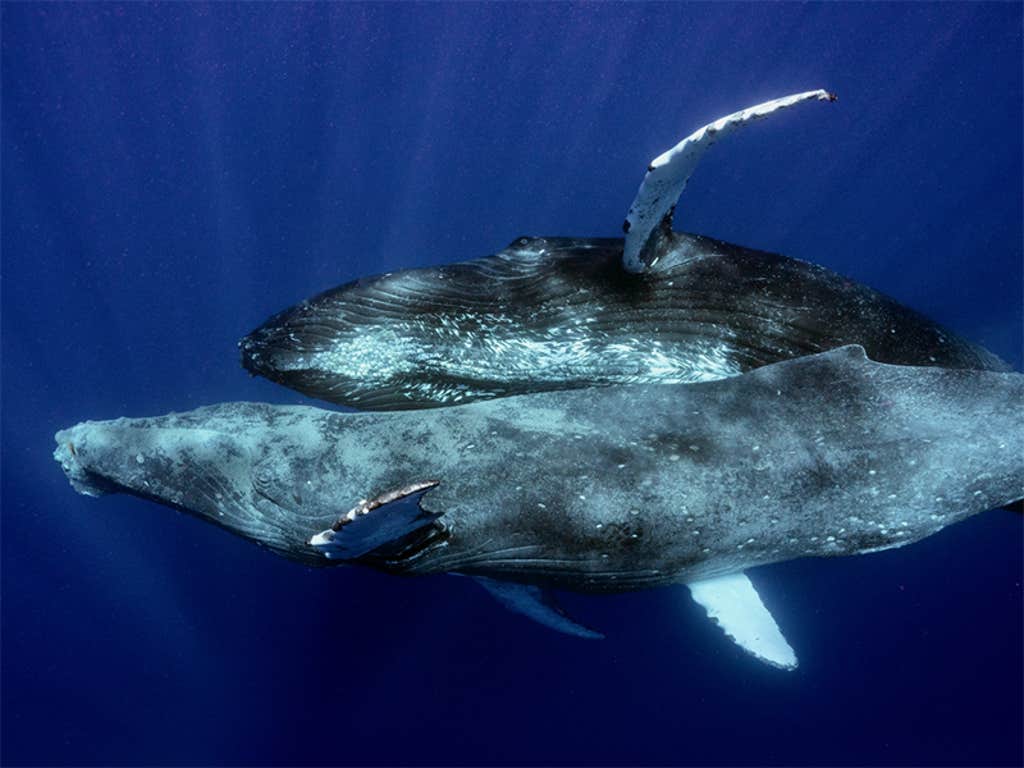Two photographers in Maui, out on a boat, spotted a pair of humpback whales in January 2022. They cut the engine and drifted, as the whales approached their boat and began to circle, just 15 feet or so below the surface. Dipping their cameras a foot into the water, they started snapping pictures.
Over the next half hour, the photographers caught the first recordings known to science of humpback whales having sex. With its pectoral fins, one whale gripped the other skinnier whale, which was covered in lice, and penetrated its genital slit in what seemed like a shallow way. The skinny whale seemed to attempt to wriggle free of the other whale’s grip, but it didn’t succeed.

The photographers sent their photos to Stephanie Stack, a whale researcher with the Pacific Whale Foundation. When she looked at the photos, she saw something they hadn’t noticed: Both whales were male, which was clear from identifying marks on the tail flukes of the skinnier whale. “At first they thought they had found two humpback whales mating,” Stack says. “It was already an exciting discovery—and then there was this whole other level to the story.”
Humpback whales are among the best-studied cetaceans in the world. Even so, many mysteries remain about their behavior. The first partial observation of a humpback whale birth only happened in 2020, when a whale watching company used a pole-mounted underwater camera to capture the scene. And despite active study of humpbacks during breeding season, sexual behaviors had never been witnessed until now.
It’s the first time humpback sex of any kind has been observed.
“They’re marine mammals, living under the water, so we as humans have a lot of limitations in studying them,” says Stack. In a paper published this week in the journal Marine Mammal Science, Stack and the two photographers described the event and what it might mean.
In general, homosexual behavior is incredibly common in the animal world, says Stack. Among marine mammals, same-sex behavior has been observed in a number of cetaceans, including Amazon river dolphins, killer whales, and gray whales.
“When we think about animal behavior, we don’t want to interpret it through a human perspective,” she says. “Instead, we want to think about how it might give them an evolutionary advantage.”
In some cases, that could mean that sexual behavior helps develop close relationships between kin, or increase social bonds in a group. But in the scenario the photographer recorded, the purpose of the behavior is tough to deduce because it’s the first time humpback sex of any kind has been observed, Stack says.

One of the whales was in poor condition—skinny and lethargic, with an injury on its jaw. Stack suspects it had been struck by a ship, adding another layer of complexity to the story. The act of copulation could have served as an assertion of dominance over an injured competitor—or not. “We don’t know right now if the whale’s injured status is what led to this behavior,” she says. “Maybe it was just a coincidence and this is a common behavior.” We have no idea what is typical sexual behavior for humpback whales.
The photographs are a reminder of the important role that citizen scientists can play in documenting the majestic creatures’ behavior, says Stacks. “It’s so great that people are aware and reaching out,” she says, and that the photographers followed all the conservationist laws for whale watching, including stopping the boat’s movement and staying on the vessel, not getting in the water with the whales.
It is difficult to design a scientific experiment to study whale reproduction in the wild, Stacks says, but there are some new technologies that can help answer questions about what happens under the waves. Suction-cup tags with video capabilities may help scientists capture what the world is like for a whale. Drones can also provide a birds-eye view of whale activity at the surface, and can be operated remotely or autonomously. Stacks adds, “with more eyes on the water, we’re starting to capture more footage.” ![]()
Photos by Lyle Krannichfeld & Brandi Romano.
































